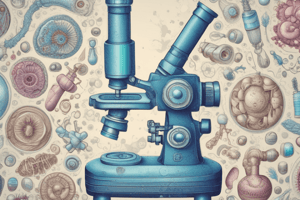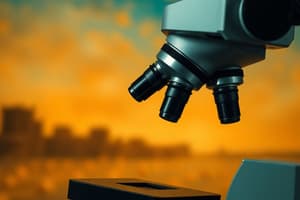Podcast
Questions and Answers
Robert Hooke published treatise 'Micrographia' using a simple ______.
Robert Hooke published treatise 'Micrographia' using a simple ______.
microscope
The objective lens of a compound microscope projects a magnified image into the ______ tube.
The objective lens of a compound microscope projects a magnified image into the ______ tube.
body
Bright Field Microscope produces a dark image to a light ______.
Bright Field Microscope produces a dark image to a light ______.
background
Total magnification of a microscope is calculated by multiplying the eyepiece by the ______.
Total magnification of a microscope is calculated by multiplying the eyepiece by the ______.
Most commercial magnifiers produce a magnification of x2 to ______.
Most commercial magnifiers produce a magnification of x2 to ______.
The ______ lens magnifies the image formed by the objective lens.
The ______ lens magnifies the image formed by the objective lens.
The ______ holds the objectives of the microscope.
The ______ holds the objectives of the microscope.
The distance between two front surfaces of the lens and the specimen is called the ______.
The distance between two front surfaces of the lens and the specimen is called the ______.
The ______ controls the intensity of light produced.
The ______ controls the intensity of light produced.
The ______ microscope does not allow light to pass directly through the specimen.
The ______ microscope does not allow light to pass directly through the specimen.
The technique that uses fluorescent stains is known as ______ microscopy.
The technique that uses fluorescent stains is known as ______ microscopy.
An opaque disk with a thin transparent ring is called an ______ stop in phase-contrast microscopy.
An opaque disk with a thin transparent ring is called an ______ stop in phase-contrast microscopy.
The numerical aperture (NA) describes the ______ gathering ability of the lens.
The numerical aperture (NA) describes the ______ gathering ability of the lens.
The ______ microscope uses magnets to focus beams on the object being viewed.
The ______ microscope uses magnets to focus beams on the object being viewed.
Ernst Abbe formulated the ______ sine equation.
Ernst Abbe formulated the ______ sine equation.
Flashcards are hidden until you start studying
Study Notes
Microscopy Overview
- Robert Hooke published "Micrographia," a pioneering treatise on microscopy.
- Simple microscopes have a single bi-convex lens, primarily for dissection and observing bacterial colonies.
- Limitations of simple microscopes include low amplification (x2 to 30) and resolution (around 10 μm) due to low Numerical Aperture (NA).
Compound Microscope
- First developed by Zaccharias and Hans Janssen in 1590.
- Features two lenses: an objective lens near the specimen and an ocular lens near the eye, allowing for two-stage magnification.
- Significantly enhances viewing capabilities compared to simple microscopes.
Bright Field Microscope
- Produces dark images against a light background through visible light transmission.
- Total magnification calculated as eyepiece magnification multiplied by the objective’s power (e.g., 10x eyepiece and 100x objective yields 1000x).
- Key components include:
- Ocular Lens: Magnifies the objective's image.
- Body Tube: Transmits images to the ocular.
- Arm: Supports the microscope.
- Nosepiece: Holds objectives.
- Objective Lenses: Primary magnifying lenses.
- Mechanical Stage: Holds slides in place.
- Condenser: Focuses light on the specimen.
- Diaphragm & Rheostat: Control light intensity and amount.
- Adjustment Knobs: Coarse adjusts under low power; fine sharpens under all objectives.
- Illuminator: Provides necessary light.
Resolution and Numerical Aperture
- Resolution defined as the detail fidelity in magnified images.
- Ernst Abbe formulated the Abbe sine equation: d = 0.5λ/(n sin θ).
- Shorter wavelengths (450-500 nm) yield higher resolution, crucial for distinguishing close objects.
- NA indicates a lens's light-gathering ability; higher NA correlates to lower working distance.
Objective Lens Characteristics
- Scanning: 4x, NA 0.10, color red.
- Low Power Objective (LPO): 10x, NA 0.25, color yellow.
- High Power Objective (HPO): 40x, NA 0.65, color blue.
- Oil Immersion: 100x, NA 1.25, color white.
Dark Field Microscope
- Functions oppositely to bright field; light enters at oblique angles.
- Ideal for viewing spirochetes and other unstained microorganisms.
Phase-Contrast Microscope
- Designed for samples with low refractive indices, visualizing organelles without staining.
- Produces bright backgrounds with dark specimen images due to light beam deflection.
- Utilizes an annular stop condenser to create a hollow cone of light.
Fluorescence Microscope
- Employs fluorochromes that fluoresce under UV or visible light exposure.
- Common fluorochromes include acridine orange, auramine, and FITC.
- Converts radiant energy in molecules to fluorescence, used for detailed visualization.
Electron Microscope
- Utilizes electrons instead of light, capable of magnifying significantly smaller objects.
- Operates in a vacuum to prevent interference from air molecules.
- Produces an image via a monitor, allowing for high-resolution observation.
Studying That Suits You
Use AI to generate personalized quizzes and flashcards to suit your learning preferences.




